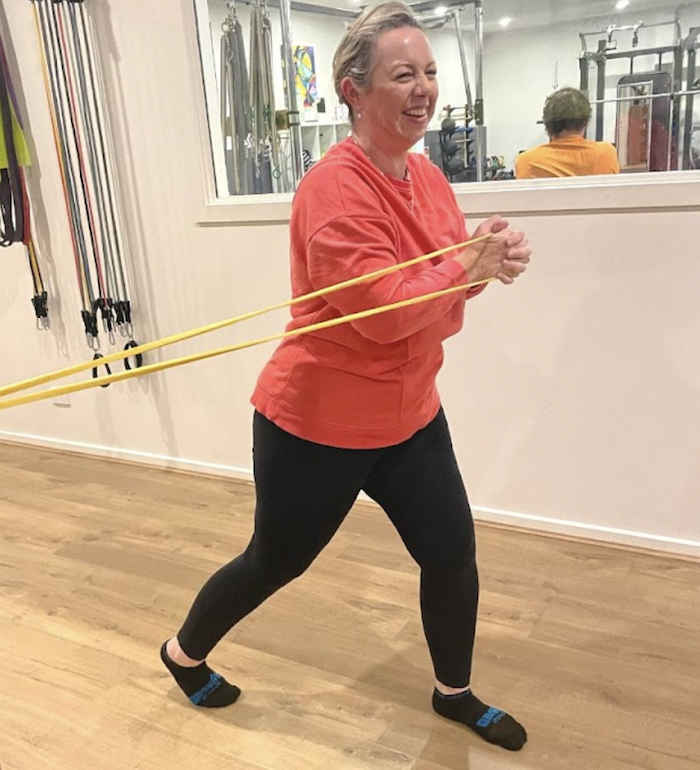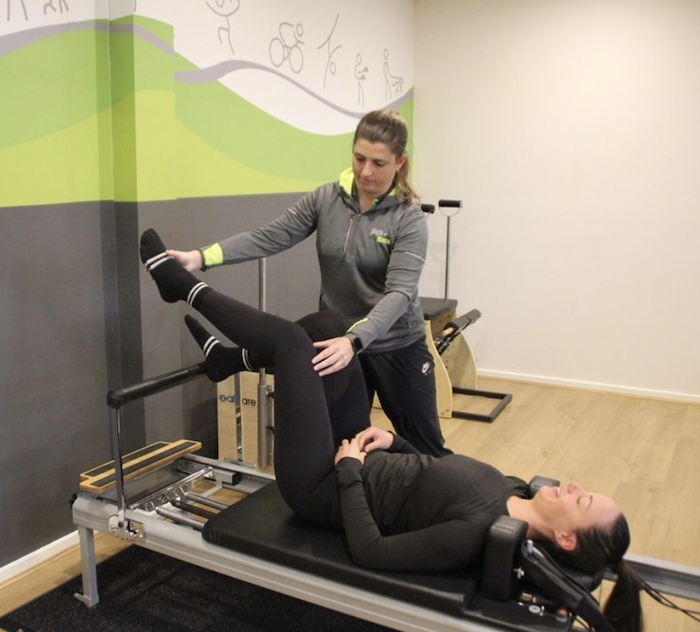Treatment for Postpartum Intermittent Hip, Back & Foot Pain
Our case study with Prue demonstrates how to overcome intermittent hip, back and foot pain after birth.
Coming back from a later in life baby!
Prue has shown true grit this last year after having her second baby, 12 years after her first! 🙃
With her beautiful second boy came some challenges (some pre existing, some related to having a new bundle of joy to care for).
This included;

Postpartum back, hip and foot pain assessment
With Prue’s assessment it was found that;
More body weight on one side – she had more of her body weight over to her left side, and it was theorized that this may be contributing to the consistent injuries on one side of her body.
Lacking rotation – She lacked rotation to the left, which likely meant with movement in this direction she was relying on her lower back and hips more than her body was okay with, resulting in muscle tightness and nerves being pinched.
Tight ribcage – We found that in particular, her thoracic (ribcage) region were very tight.
Tightness in feet – as well as her foot were very tight, and by releasing both, this enabled better movement within the ribcage and the feet. This is turn helped her hip feel better.
Treatment for Postpartum intermittent hip back & foot pain
Hands on Physiotherapy treatment – Several sessions with our physiotherapist Morgan, to provide hands on treatment.
At-Home Exercises – we coupled this with some home exercises (focused on mobility around the two areas).
Pilates program – Prue undertook clinical pilates sessions with physiotherapist Kirra-Lee.
Pilates program postpartum for Prue focussed on the following…
- Mobility through her thoracic (for example, banded rotations/ chest openers/ reformer presentation arms)
- Foot balance and stability with increasing difficulty (for example, stepping up whilst resisting a band, Arabesque pose, standing reformer work)
- Glute activation in different planes of movement (for example side-lying glutes on the trapeze, chiball-based work)
- Core strength (for example reformer based abdominal exercises)

Mobility through her thoracic
(for example, banded rotations/ chest openers/ reformer presentation arms)
Foot balance and stability
With increasing difficulty (for example, stepping up whilst resisting a band, Arabesque pose, standing reformer work)
Glute activation
In different planes of movement (for example side-lying glutes on the trapeze, chiball-based work)
Core strength
For example reformer based abdominal exercises.
Can you have more body fat on one side than another?
Having a higher concentration of body weight in one area of the body compared to another is a common occurrence and can be influenced by various factors such as genetics, posture, and weight distribution.
However, if you have any concerns or worries, it’s best to consult with a healthcare professional. They can conduct a thorough physical examination and offer their expert medical opinion.
In some cases, they may recommend additional tests like an ultrasound or MRI to help identify the underlying cause of the variation in fat distribution.
Why could you have more body weight on one side postpartum?
It could be a variety of factors such as;
- Genetics
- Posture
- Weight distribution
- Breastfeeding on one side over the other
- Preference in holding the baby on one side to the other
What are the Symptoms of Postpartum Hip Pain?
Pregnancy brings about numerous hormonal changes and physical adaptations in the body to support the growing baby. As the baby grows larger and heavier, it can exert pressure on the sciatic nerve, resulting in hip pain.
However, if this pain persists after childbirth, it is often caused by other factors unrelated to pregnancy.
Some common causes of postpartum hip pain are:
- Reduced strength of the muscles
- Abdominal separartion
- Labral tears
- Hormones and breastfeeding.
- Lifting and holding a baby
- Leaning over a cot
How to Ease Hip Pain After Pregnancy?
You may benefit from wearing a pelvic brace and exercises. However, it is best to consult with a health professional.
Is it easier to bounce back from a first pregnancy than a second?
The body typically takes about six weeks to heal after a first pregnancy. However, for subsequent pregnancies, the recovery process may take longer, and that’s normal.
After carrying and giving birth to another baby, you might experience weight gain, stretch marks, separated abdominal muscles, a weaker pelvic floor, and wider hips.
Keep in mind that these changes vary from person to person. Some of these changes may persist over time (such as wider hips), while others (like abdominal separation) can be addressed with proper care and treatment.
Not only do you have a baby to look after, but also a toddler or older child/teenager in Prue’s case.
Why do I have foot pain postpartum?
Postpartum foot or heel pain is a common issue that many women experience when they first get up after sitting or lying down for a while. This discomfort can be attributed to plantar fasciitis, which involves inflammation and tearing in the tissue on the bottom of your feet. It can be referred pain from your back and hips.
One possible cause of this condition is fallen arches, which put excessive stress on the plantar fascia. Unfortunately, even after giving birth, you may still be experiencing foot pain due to this underlying problem. Fortunately, there are various methods for managing this pain such as using shoe inserts/orthotics and elevating your feet.
However, if these home treatments do not provide relief for the ball of your foot or heel pain it’s crucial to seek assistance from an experienced podiatrist or physiotherapist before the situation worsens further causing more damage and discomfort.
How can I release foot pain?
You can release the middle/inside of the foot using a hard physio ball. This is also a great technique for people with “shin splint” or Tibialis posterior issues.
What does treatment look like for base of foot pain?
Often base of foot stiffness is a sign of an injury that is higher up.
Plantar fasciitis is a painful condition that occurs when the plantar fascia, a strong and thick tissue running along the bottom of the foot, becomes inflamed. This tissue connects the heel bone to the toes and plays a crucial role in supporting the arch of your foot.
Often caused by overstretching, overuse, or certain medical conditions, plantar fasciitis can lead to significant discomfort and heel pain. It’s important to seek proper treatment and take necessary steps to prevent further aggravation of this condition.
Please remember
All pregnancies, postpartum experiences and injuries are different. So please consult a medical professional before performing any of the exercises we have suggested.
If you are in the Seaford area of Melbourne, please book in for an appointment with one of our Physiotherapists.
